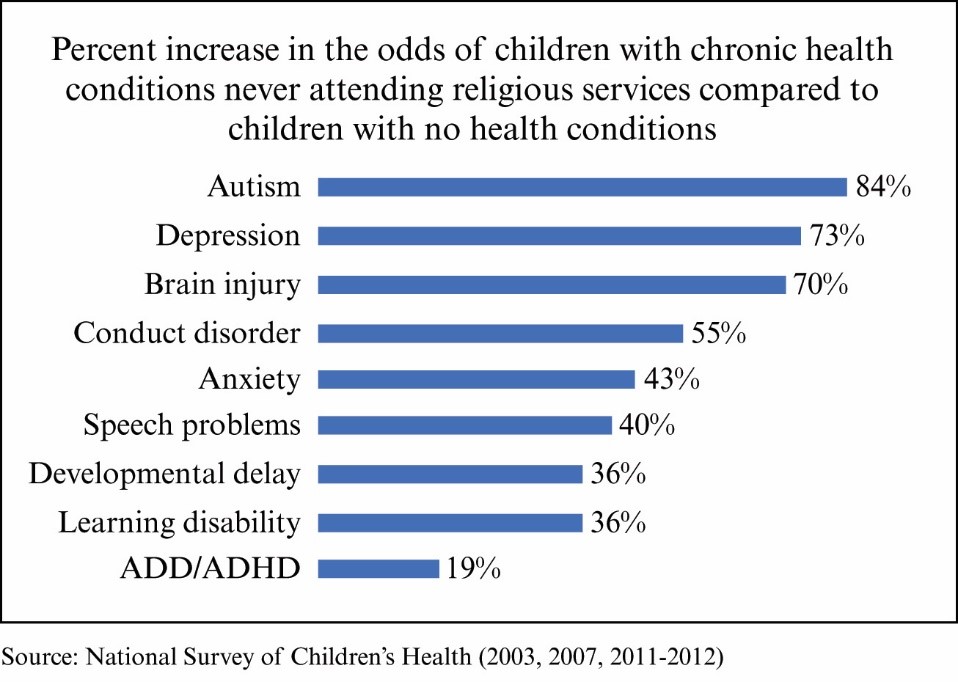By Craig Cable
It goes without saying that church should be a warm, welcoming, and safe space for everyone who is looking for community, worship, and spiritual growth. Unfortunately, there are thousands of families who have a deep desire to connect with a faith community, but barriers exist that preclude them from doing so.
This challenge is probably most felt by parents who have children with autism.
What is autism?
Autism, or Autism Spectrum Disorder (ASD), is not a single type of disorder but a wide range of conditions characterized by behavioral challenges, limited communication, impaired social skills, and repetitive behaviors. According to the Centers for Disease Control, ASD affects 1 in 59 children in the United States. Some experts say it’s four times more prevalent in boys than girls.
According to the National Survey of Children’s Health, autism tops the chart when it comes to the odds of children with chronic health conditions never attending religious services compared to children with no health conditions. (See chart below)

What are the challenges of ministering to children with ASD?
When it comes to addressing some of the challenges associated with ASD, a national organization called Autism Speaks offers the following insights:
- An estimated one-third of people with ASD are nonverbal.
- 31% of children with ASD have an intellectual disability with significant challenges in daily function.
- Nearly half of those with ASD wander or bolt from safety.
- Nearly two-thirds of children with ASD between the ages of 6 and 15 have been bullied.
- Nearly 28% of 8-year-olds with ASD have self-injurious behaviors such as head banging, arm biting, and skin scratching.
Children with ASD often have an extreme attraction to busy streets and water, and are nearly three times more likely to die from an unintentional injury than the general population. The leading cause of death for children with ASD under the age of 15 is drowning, suffocation, and asphyxiation. Those three causes accounted for nearly 80% of the total injury deaths in children with ASD.
If you consider the very real need for parents of children with ASD to be hypervigilant, it’s understandable why they would be reluctant to leave their child in the care of a children’s or youth ministry that isn’t equipped to protect them.
To put a face to the safety and involvement challenges, here’s what a friend of mine whose son has ASD had to say…
“We actually just left our church of several years for this reason. My son was getting no support in his class. While the other kids were doing crafts or singing, he was playing by himself. I would have to get up halfway through the service to take him to the bathroom. When it comes to safety concerns, my son was able to walk out of his classroom twice. They never noticed because they were busy with the other children. Both times my son made it outside of the building. There is NOTHING scarier than that! We recently started attending another church. They offer a ministry for kiddos with special needs. There is either a 1/1 or a 2/1 ratio. So far, my son has his own Para–someone to help him with crafts, sit with him during Bible study, and take him to the bathroom. For the first time he’s being included. I realize that this takes extra volunteers for the class, but I feel this is a need that people don’t think about unless THEY have the special needs child. If this need was addressed with the congregation, I feel more people would volunteer to help.”
My friend felt that she had no other choice but to leave her established church to find another that could accommodate the safety and ministerial needs of her son. You can imagine how many families with ASD simply walk away from church entirely because there is no other option. Similarly, you can see how a ministry that is trained and equipped to serve those with ASD would be a welcomed and much-needed support system for these parents.
Understanding challenging behavior
When it comes to developing a special needs ministry, the most common barrier that I hear from churches is a concern over how to manage behavioral issues that can occur with children who have ASD. Because autism is a spectrum disorder, what may work for one child won’t necessarily work with another child. While the frequency and severity of these behaviors can vary greatly based on the child and situation, it’s understandable why churches are reluctant to take on this responsibility.
Some of these behaviors can include:
- Being disruptive or aggressive, such as yelling, banging, throwing objects, hitting, or kicking
- Bolting or wandering away from the caretaker
- Urinating or defecating in their pants or on the floor
- Not following directions or not willing to follow simple tasks
- Obsessing about things or compulsive rituals
- Self-injury in the form of hitting, biting, head banging, or hair pulling
It’s helpful to understand that these behaviors, while challenging, are a form of communication. It’s likely that their behavior is intended to serve a function or produce a desired outcome. It may be that they’re feeling overwhelmed and need a break or that they want something and just lack the ability to communicate what it is. Think of it more as a response than a willful act of disobedience.
According to the experts at Autism Speaks, behavior generally serves one of several functions:
- Obtaining a desired object or outcome
- Escaping a task or situation
- Getting attention, either positive (praise) or negative (yelling)
- Trying to self-calm, self-regulate, or feel good (sensory input)
- Blocking or staying away from something painful or bothersome (sensory avoidance)
- Responding to pain or discomfort
- Attempting to gain control over an environment or situation (self-advocacy)
Recommendations for keeping kids with ASD safe
When it comes to providing a safe environment for children with ASD, there are a lot of things to consider. Having the right people, the right training, the right environment, and the right plan are all essential elements to providing a safe place.
Provided below are recommendations for keeping children with ASD safe and secure:
- The Right People: You’ll need enough volunteers to provide a 1-to-1 or 2-to-1 student to volunteer ratio. Ideally, your volunteers would also have experience in working with ASD children.
- The Right Training: There are a lot of great national organizations out there to help train volunteers. I have provided links to some of those resources below. But don’t limit training to just the ones serving in the ministry. Be sure to train your church’s safety team volunteers on ways they can provide assistance or what to do if a child tries to escape.
- The Right Environment: Because children with ASD are often highly sensitive to sound or over stimulation, make sure the room is designed for those with special needs. You will also want to have a designated area (outside of the room) where the child can safely calm down so as not to upset other children. Because ASD children are prone to escape, make sure safety measures are in place that would prevent the child from leaving the room (or worse, the building) and/or accessing areas of the church that aren’t safe.
- The Right Plan: A plan needs to be tailored for each child and must involve input from the parents. Having the parents speak into the child’s care and safety plan, and then documenting what that plan is, will help avoid potential problems down the road.
I want to encourage church leaders to prayerfully consider the opportunity to invest time and resources into serving families with ASD and other special needs. If you consider the sheer number of families who are desperately looking for a church that can accommodate the needs of their child, this is a huge ministry opportunity that is currently being underserved.
The following is a list of several national organizations that are serving the needs of the autistic community.
Autism Speaks: https://www.autismspeaks.org/
Autism Now: https://autismnow.org/
American Academy of Pediatrics – Autism initiatives: https://www.aap.org/en-us/advocacy-and-policy/aap-health-initiatives/Pages/autism-initiatives.aspx
Autism Society: https://www.autism-society.org/
Autistic Self Advocacy Network: https://autisticadvocacy.org/
National Autism Association: https://nationalautismassociation.org/


